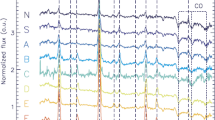Abstract
The recent survey of H 272α recombination line (324.99 MHz) in the direction of 34 Hn regions, 12 SNRs and 6 regions of continuum minimum (‘blank’ regions) in the galactic plane is used to derive the properties of diffuse ionized gas in the inner Galaxy.
The intensity of radio recombination lines at high frequencies is dominated by spontaneous emission in high-density gas and that at low frequencies (325 MHz) by stimulated emission in low-density gas. We have used this property to obtain the electron density in the gas in the direction of blank regions and SNRs, by combining the H 272 α measurements (preceeding paper) with the published data at higher frequencies. Further, we have imposed constraints on the electron temperature and pathlength through this gas using the observed high-frequency continuum emission, average interstellar electron density and geometry of the line-emitting regions. The derived properties of the gas are (i) electron density 0.5–6 cm-3, (ii) electron temperature 3000–8000 K and (iii) emission measures 500–3000 pc cm-6 The corresponding pathlengths are 50–200 pc.
As the derived sizes of the low-density regions are small compared to the pathlength through the Galaxy, the low-frequency recombination lines cannot be considered as coming from a widely distributed component of the interstellar medium.
The Hn regions studied in the above survey cannot themselves produce the H 272α lines detected towards them because of pressure broadening, optical depth, and beam dilution. However, the agreement in velocity of these lines with those seen at higher frequencies suggests that the low-frequency recombination lines arise in low-density envelopes of the Hn regions. Assuming that the temperature of the envelopes are similar to those of the cores and invoking geometrical considerations we find that these envelopes should have electron densities in the range 1–10 cm-3 and linear sizes of 30–300 pc in order to produce the observed H 272α lines.
Similar content being viewed by others
References
Altenhoff, W. J., Downes, D., Goad, L., Maxwell, A., Rinehart, R. 1970,Astr. Astrophys. Suppl.,1, 319.
Altenhoff, W. J., Downes, D., Pauls, T., Schraml, J. 1978,Astr. Astrophys. Suppl.,35, 23.
Anantharamaiah, K. R. 1985a,J. Astrophys. Astr.,6, 177, (Paper 1).
Anantharamaiah, K. R. 1985b, In preparation.
Bignell, R. C. 1973,Astrophys. J.,186, 889.
Brocklehurst, M., Leeman, S. 1971,Astrophys. Lett.,9, 35.
Brocklehurst, M., Salem, M. 1977,Computer Phys. Commun.,13, 39.
Brocklehurst, M., Seaton, M. J. 1972,Mon. Not. R. astr. Soc.,157, 179.
Brown, R. L., Lockman, F. J., Knapp, G. R. 1978,A. Rev. Astr. Astrophys.,16, 445.
Cesarsky, D. A., Cesarsky, C. J. 1973a,Astrophys. J.,183, L143.
Cesarsky, D. A., Cesarsky, C. J. 1973b,Astrophys. J.,184, 83.
Clark, D. H., Caswell, J. L. 1976,Mon. Not. R. astr. Soc,174, 267.
Downes, D., Wilson, T. L. 1974,Astr. Astrophys.,34, 133.
Downes, D., Wilson, T. L., Bieging, J., Wink, J. 1980,Astr. Astrophys. Suppl.,40, 379.
Dulk, G. A., Slee, O. B. 1972,Aust. J. Phys.,25, 429.
Dulk, G. A., Slee, O. B. 1975,Astrophys. J.,199, 61.
Gordon, K. J., Gordon, C. P., Lockman, F. J. 1974,Astrophys. J.,192, 337.
Gordon, M. A., Brown, R. L., Gottesman, S. T. 1972,Astrophys. J.,178, 119.
Gordon, M. A., Cato, T. 1972,Astrophys. J.,176, 587.
Gordon, M. A., Gottesman, S. T. 1971,Astrophys. J.,168, 361.
Gottesman, S. T., Gordon, M. A. 1970,Astrophys. J.,162, L93.
Griem, H. R. 1967,Astrophys. J.,148, 547.
Hart, L., Pedlar, A. 1976a,Mon. Not. R. astr. Soc.,176, 135.
Hart, L., Pedlar, A. 1976b,Mon. Not. R. astr. Soc,176, 547.
Haynes, R. F., Caswell, J. L., Simons, L. W. J. 1978,Aust. J. Phys. Astrophys. Suppl.,45, 1.
Jackson, P. D., Kerr, F. J. 1971,Astrophys. J.,168, 29.
Jackson, P. D., Kerr, F. J. 1975,Astrophys. J.,196, 723.
Lockman, F. J. 1976,Astrophys. J.,209, 42.
Lockman, F. J. 1980, inRadio Recombination Lines, Ed. P. A. Shaver, D. Reidel, Dordrecht, p. 185.
Mebold, U., Altenhoff, W. J., Churchwell, E., Walmsley, C. M. 1976,Astr. Astrophys.,53, 175.
Oster, L. 1961,Rev. Mod. Phys.,33, 525.
Osterbrock, D. E. 1974,Astrophysics of Gaseous Nebulae, Freeman, San Francisco.
Pankonin, V. 1975,Astr. Astrophys.,38, 445.
Pankonin, V., Parrish, A., Terzian, Y. 1974,Astr. Astrophys.,37, 411.
Parrish, A., Conklin, E. K., Pankonin, V. 1977,Astr. Astrophys.,58, 319.
Pedlar, A., Davies, R. D. 1980, inRadio Recombination Lines, Ed. P. A. Shaver, D. Reidel, Dordrecht, p. 171.
Pedlar, A., Davies, R. D., Hart, L., Shaver, P. A. 1978,Mon. Not. R. astr. Soc,182, 473.
Pedlar, A., Matthews, H. E. 1973,Mon. Not. R. astr. Soc,165, 381.
Radhakrishnan, V., Goss, W. M., Murray, J. D., Brooks, J. W. 1972,Astrophys. J. Suppl. Ser.,24, 49.
Salem, M., Brocklehurst, M. 1979,Astrophys. J. Suppl.,39, 633.
Shaver, P. A. 1975,Pramana,5, 1.
Shaver, P. A. 1976,Astr. Astrophys.,49, 1.
Shaver, P. A., Goss, W. M. 1970,Aust. J. Phys. Astrophys. Suppl.,14, 133.
Silvergate, P. R., Terzian, Y. 1979,Astrophys. J. Supp.,39, 157.
Spitzer, L. 1978,Physical processes in the Interstellar Medium, Wiley-Interscience, New York.
Viner, M. R., Vallée, J. P., Hughes, V. A. 1979,Astr. J.,84, 1335.
Vivekanand, M., Narayan, R. 1982,J. Astrophys. Astr.,3, 399.
Wilson, T. L. 1980, inRadio Recombination Lines, Ed. P. A. Shaver, D. Reidel, Dordrecht, p. 205
Author information
Authors and Affiliations
Rights and permissions
About this article
Cite this article
Anantharamaiah, K.R. Low density ionized gas in the inner galaxy — Interpretation of recombination line observations at 325 MHz. J Astrophys Astron 6, 203–226 (1985). https://doi.org/10.1007/BF02715006
Received:
Accepted:
Issue Date:
DOI: https://doi.org/10.1007/BF02715006



